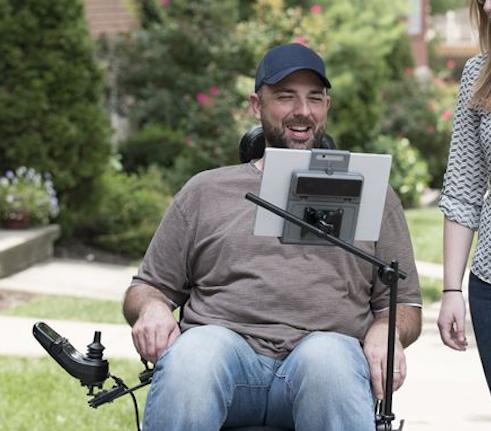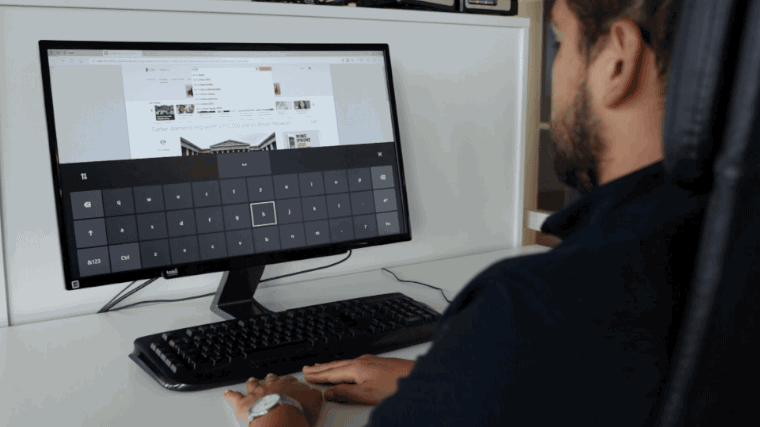
First, your body betrays you. The muscles that you once relied upon for movement and so many forms of self-reliance begin to weaken, then wither. You are unable to write. Your world closes in on you.
Then, as the muscles which normally aid speech gradually fail to function, your world gets even smaller, and claustrophobic, as any ability to share your thoughts with your loved ones disappears. In a continuum of frightening moments for someone with amyotrophic lateral sclerosis, commonly known as ALS, that must be one of the most terrifying.
All of which makes the technology that allows someone to communicate written sentences solely with their eyes truly incredible. And this fascinating device provides at least some merciful measure of freedom for those trapped by the progressive, unceasing horrors of Lou Gerhig's Disease.
“Technology is basically a link to life for people with ALS,” said Alisa Brownlee of the ALS Association, who works with technology that helps sufferers, speaking to Slate in August. “As the disease progresses a lot of folks become isolated due to the fact that it’s such a burden to even get out the door. Our patients rely on the internet for everything: to do their shopping, get on social media, and see what their families are up to.”
 It's called eye-tracking technology because that's what it does. A sensor is mounted to the bottom of the screen, and near-infrared light, or NIR, is trained on the eyes and basically logs what the eyes are focusing on. The user then can stare at letters on the screen's keyboard, and assemble letters into words, and words into sentences. And similar to how the auto-correct feature on your smartphone "knows" what word you are trying to tap out, algorithms are at work to construct what the ALS patient is trying to "write."
It's called eye-tracking technology because that's what it does. A sensor is mounted to the bottom of the screen, and near-infrared light, or NIR, is trained on the eyes and basically logs what the eyes are focusing on. The user then can stare at letters on the screen's keyboard, and assemble letters into words, and words into sentences. And similar to how the auto-correct feature on your smartphone "knows" what word you are trying to tap out, algorithms are at work to construct what the ALS patient is trying to "write."
Roughly 80 percent of ALS sufferers succumb to the disease within 2-5 years of being diagnosed, according to the Centers for Disease Control, which adds that "males have a higher prevalence than females" of being afflicted and that ALS is found to be more common among whites and those 60 to 69 years of age.
In 2013, the last year where figures were available, the CDC identified nearly 16,000 cases of ALS. From a clinical standpoint, the agency says its "uniformly fatal, typically due to respiratory failure." We don't know what causes it, and there is no known cure.
Since those afflicted know that death is a certainty in the near term, extending their ability to communicate matters so much more, and the large majority of patients need help to do so.
"People with ALS present the greatest challenge regarding communication issues," as "[a]pproximately 75% of all people diagnosed with ALS will need some form of communication assistance," according to the ALS Association. "While progression of speech disturbance varies in each person with ALS, most people will experience a severe communication disorder during the last few months of life. In a retrospective study of 100 hospice patients with ALS, 28% were anarthric (unable to speak) and 47% were severely dysarthric (slurred speech) at the time of their deaths. Only 25% could speak understandably during the terminal stage of the illness."
While the costs of eye-tracking technology have always been quite expensive, reportedly running in excess of $10,000 per machine, one hardware manufacturer, Tobii, has partnered with Microsoft, developing software that hopes to significantly lower the cost to make the technology more accessible to ALS patients.
There are other uses for the technology, to enhance productivity and improve online gaming, adding to the potential market for the device. But any effort to make this brilliant technology more available to those devastated by ALS, by lowering its cost, is welcome news.



